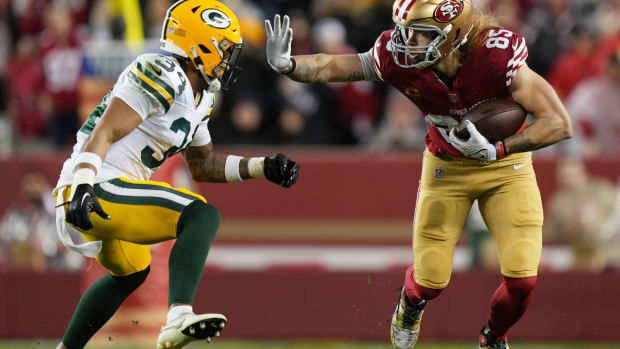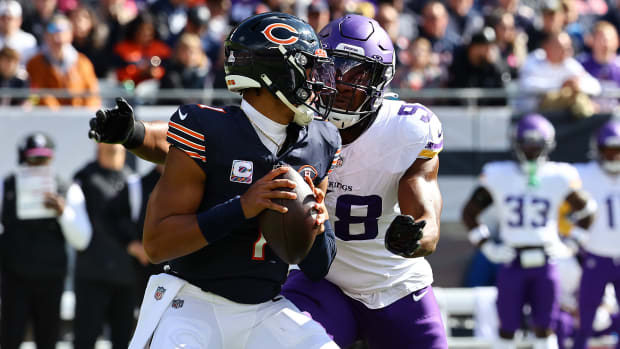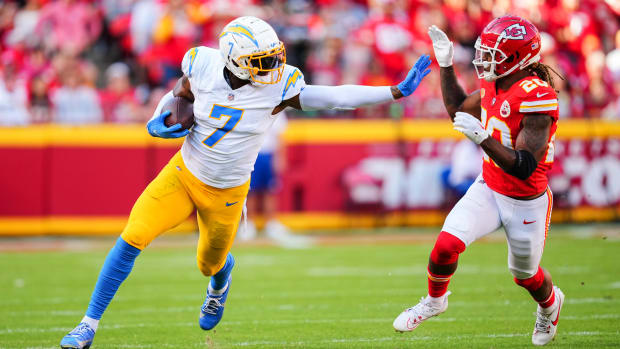Bears 2020 Preview: QB Question Is One Issue Among Many
Upon arriving at Halas Hall and meeting new teammates at training camp, Chicago Bears safety Tashaun Gipson seemed a bit overwhelmed.
"Elite," Gipson said. "I think that's the first word that comes to mind when you think about joining a defense like that."
Gipson's description applies only to one side of the football.
While many current Bears defensive players formed a dominant group the last two years, the offense has continued to flounder.
Even the trade for former Super Bowl MVP quarterback Nick Foles cannot be viewed as a reason for great optimism because of the other challenges facing their offense beyond throwing the ball.
And Foles hasn't been a consistent success.
Foles in eight seasons has experienced great swings in productivity, from Super Bowl to face-first dives into NFL oblivion. Nevertheless, he seems more suited to running coach Matt Nagy's Kansas City-style offense than inconsistent Mitchell Trubisky, whose deep passing accuracy seems a constant problem.
A struggling offensive line and a patchwork tight end group could make life more difficult or better for whichever quarterback emerges with the job.
Potential exists for disaster or success, and general manager Ryan Pace’s job status could be tied to it all if last year’s decline from 12-4 to 8-8 becomes a trend.
Defense
Several elements changed for a defense ranked fourth in points allowed last year and first in 2018. Some of these were for the better, but others are more questionable.
“We want to be the Monsters of the Midway,” defensive coordinator Chuck Pagano said. “We want to wreak havoc.”
Whether this is possible with two changes in the secondary and after nose tackle Eddie Goldman opted out, are burning questions.
“He’s one of those guys who puts his head down and goes to work,” linebacker Danny Trevathan said of Goldman. “To have him not here, we’re definitely missing a key part.”
Stopping the run has been one of this defense’s trademarks and it won’t be helped by losing Goldman. Moving starter Bilal Nichols inside from end to nose in the 3-4 could offset this.
With Trevathan and Roquan Smith now healthy at inside linebacker following season-ending injuries, stopping the run might not be a huge issue even without Goldman.
The Bears failed to regularly take away the ball last year and it was one key difference from their 2018 dominance, but this could change.
The drop from 27 to 10 interceptions was alarming, and now they are trying to deal with lineup changes, including Gipson at safety and possibly rookie Jaylon Johnson at right cornerback.
They could generate turnovers with pressure. With defensive end Akiem Hicks healthy after missing three-quarters of last year, Khalil Mack looking to rebound after an 8 ½-sack season and new edge rusher Robert Quinn balancing out the rush, pressure on quarterbacks can mean more interceptions for defensive backs like safety Eddie Jackson and cornerback Kyle Fuller.
“I don't really see a ceiling for this group,” Mack said. “Whatever we want, that's what we're going to get.”
Lack of depth at some positions and the unsettled right cornerback spot loom as potential spoilers for Mack's assessment.
Offense
Even if the Bears had quarterback figured out, they’d still have problems to solve on offense.
The running game last year averaged 3.7 yards a carry, their worst total since 2007. They only added former Seahawks right tackle Germain Ifedi at right guard and anticipate coaching changes will benefit their approach on the ground.
Offensive coordinator Bill Lazor and line coach Juan Castillo have set about altering run-blocking schemes to generate more room for running back David Montgomery. With 889 yards as a rookie, the difference for Montgomery achieving a 1,000-yard season was more breakaway runs.
Montgomery and the line need to address this.
“In regards to Week 1, we’re not going to know fully until we get into it as to how effective or how much better our run game does get, or our offense in general,” Nagy said.
The quarterbacks have been surrounded with what seems to be a deeper receiver corps, both at wideout and tight end.
Tight end Jimmy Graham is 33 but in practice seems younger and capable of far more productivity than the Bears had from this position last year. Cole Kmet shows advanced skill and awareness for a rookie. The red-zone offense ranked 24th last year in touchdown percentage and should benefit from both tight ends.
Allen Robinson II established himself as one of the league’s best X receivers last year, new contract or no new contract, and Anthony Miller has begun to live up to expectations as a slot receiver.
The Bears addressed lack of receiver speed with 35-year-old Ted Ginn Jr. and rookie Darnell Mooney, leaving this area as one of their great question marks.
Also unsolved is how they can coax more big plays from explosive backs/receivers Tarik Cohen and Cordarrelle Patterson. This seems more of a design issue for Lazor and Nagy.
It all starts at quarterback, though, and Foles’ experience could be a huge factor in the offense leaping forward. Or the X factor could be Trubisky's improvement, although this has been promised often in the past.
Prediction: 9-7
Increased point production with Foles as starter and better tight end play within the red zone, along with an improved running attack should let the Bears keep their defense off the field and play more often with leads. This combination can result in more opposing turnovers and offset what will be a brutal second-half schedule, with seven of the final nine games against opponents who were in last year's playoffs.
Expected Depth Chart
Offense
QB: 1) Nick Foles; 2) Mitchell Trubisky
RB: 1) David Montgomery; 2) Tarik Cohen
WR: 1) Allen Robinson II; 2) Javon Wims
WR: 1) Anthony Miller; 2) Riley Ridley
WR: 1) Ted Ginn Jr.; 2) Darnell Mooney
TE: 1) Jimmy Graham; 2) Cole Kmet
LT: 1) Charles Leno Jr.; 2) Jason Spriggs
LG: 1) James Daniels; 2) Alex Bars
C: 1) Cody Whitehair; 2) Corey Levin
RG: 1) Germain Ifedi; 2) Rashaad Coward
RT: 1) Bobby Massie; 2) Lachavious Simmons
Defense
LDE: 1) Akiem Hicks; 2) Abdullah Anderson
NT: 1) Bilal Nichols; 2) John Jenkins
RDE: 1) Roy Robertson-Harris; 2) Brent Urban
OLB: 1) Khalil Mack; 2) Trevis Gipson
ILB: 1) Roquan Smith; 2) Joel Iyiegbuniwe
ILB: 1) Danny Trevathan; 2) Josh Woods
OLB: 1) Robert Quinn; 2) Isaiah Irving
LCB: 1) Kyle Fuller; 2) Stephen Denmark
S: 1) Eddie Jackson; 2) Deon Bush
S: 1) Tashaun Gipson; 2) DeAndre Houston-Carson
RCB: 1) Kevin Toliver II; 2) Jaylon Johnson
NCB: 1) Buster Skrine; 2) Duke Shelley
Special Teams
PK: 1) Eddy Pineiro; 2) Cairo Santos
P: 1) Pat O’Donnell
LS: 1) Patrick Scales
KR: Cordarrelle Patterson
PR: Tarik Cohen
Twitter: BearDigest@BearsOnMaven




